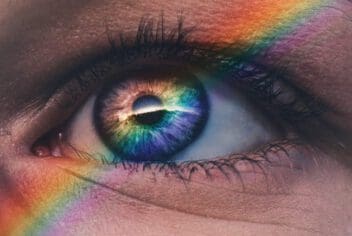Further Reading
How Does a Reverse Color Blind Test Work?
Home / Vision Education Center / Color Blindness /
Last Updated:
Table of Contents
Color blindness is a relatively easy condition to test for. At-home tests can provide a fairly accurate screening for the presence of color vision deficiency or not.
A reverse color blind test includes images and colors that only someone who is colorblind is likely to see. Someone with normal color vision would likely fail a reverse color blind test.
Reverse color blind tests are effective screening measures for color blindness, but they are not meant to provide definitive diagnostic answers.
After completing a screening at home or school, you may have additional questions about the presence of color deficiency in yourself or your child. Following up with an ophthalmologist can give you clear results.
Currently, there are no treatment options for color blindness. However, there are effective accommodations, such as special glasses, contact lenses, visual aids, and technology that greatly reduce the impact of color blindness.
Testing for Color Blindness

About 1 in 12 males and 1 in 200 women worldwide is color blind. Their color blindness, or color deficiency, is typically inherited and present at birth. People who are color blind are unable to tell the difference between certain colors.
Color blindness occurs when color-sensitive pigment in the cone cells of the retina is missing. This deficiency typically causes people to have trouble seeing red, green, blue, or a combination of these colors. People who are red-green color blind, for example, are not able to tell the difference between the two colors; they appear the same.
You deserve clear vision. We can help.
With 135+ locations and over 2.5 million procedures performed, our board-certified eye surgeons deliver results you can trust. Your journey to better vision starts here.
The standard test for color blindness is the Ishihara Color Test. An image of a circle of various colors is presented, and the person must assess if they can see a number in opposite colors inside the circle. If they cannot see the number, they may be color blind.
These are examples of Ishihara Color Tests:
What Is a Reverse Color Blind Test?
A reverse color blind test is a version of the Ishihara color test that is typically easily solved by someone who is color blind. Someone with normal vision would have difficulty seeing the number in the center of the image. If you fail a reverse color blind test, you most likely have normal, full-color vision.
The colors on a reverse color blind test are more perceptible by people who are color blind. An image is hidden within a picture that only someone who is color blind could pick up. These are examples of reverse color blind tests:
People with color vision deficiencies are better able to perceive variations in luminosity as well as better able to see at night. Additionally, color blind people are often able to identify camouflage colors better than people with normal color vision.
Are Reverse Color Blind Tests Effective?

Reverse color blind tests are effective screenings for color blindness, but they are not sufficient on their own to determine whether someone is color blind or not. If you can see the image on a reverse color blind test, it is likely you have some degree of color blindness.
After you complete a color blind or reverse color blind test at home, you may decide to follow up with your eye doctor if you have concerns about your color vision. The initial screenings, which are widely available online, can help to detect the existence of a problem.
Following up with more formal, detailed tests with an eye doctor will help determine the type and severity of color blindness you are dealing with.
You deserve clear vision. We can help.
With 135+ locations and over 2.5 million procedures performed, our board-certified eye surgeons deliver results you can trust. Your journey to better vision starts here.
Getting Tested for Color Blindness
The American Academy of Ophthalmology (AAO) explains that there are varying degrees of color blindness. Some people have mild color blindness where they only experience difficulty distinguishing colors in poor light. Other people are unable to distinguish certain colors no matter what the lighting is like.
If you are concerned that you or your child may have some form of color blindness, start by taking an Ishihara color test at home. It is a simple test that will give you dependable results right away. Color blindness is a rare and nonthreatening condition. Many people who are red-green color blind don’t even realize it.
If you are experiencing vision problems or sudden changes to your color vision, a checkup with an ophthalmologist is a good idea. While color blindness has limited impact on most people’s lives, sudden worsening of symptoms could indicate a more serious problem.
Treatment for Color Blindness
People experience color blindness on different levels, and very few people experience total color blindness where they can only see shades of grey. Most people who are color blind are able to adapt and the condition has little impact on their daily lives, explains the National Eye Institute (NEI).
Color vision tests are used to diagnose color blindness and then various accommodations can be used to improve perception of color, though the condition never goes away. NEI recommends the following treatment options:
- Glasses and contact lenses: Special glasses and contact lenses can be worn by people who are color blind in order to help them distinguish between colors more clearly.
- Visual aids: Certain visual aids, such as labels or charts around the home, work, or classroom, can help people with color blindness learn the colors of things they frequently look at.
- Technology: Apps are available to help people with color blindness identify colors of objects or spaces by taking pictures on their phones or tablets and then tapping on areas of a picture to gain information about the colors that are present.
For the most part, people are born with color deficiencies and those deficiencies remain consistent throughout their lives. People with color blindness can still see colors, just in different ways than the general population. For people with color blindness looking for better clarity in their color vision, accommodations are available.
You deserve clear vision. We can help.
With 135+ locations and over 2.5 million procedures performed, our board-certified eye surgeons deliver results you can trust. Your journey to better vision starts here.
References
- Color Blindness. (July 2019). National Eye Institute.
- Colour Blindness. Colour Blind Awareness.
- How Color Blindness Is Tested. (August 2017). American Academy of Ophthalmology.
- How Does Reverse Color Blind Test Work? (October 2018). Iris.
- Ishihara Color Test. Color Blindness.
- Reverse Color Blind Test. (January 2012). Mighty Optical Illusions.
- Comparing the Validity of an Online Ishihara Colour Vision Test to the Traditional Ishihara Handbook in a South African University Population. (August 2016). African Vision and Eye Health.
This content is for informational purposes only. It may have been reviewed by a licensed physician, but is not intended to serve as a substitute for professional medical advice. Always consult your healthcare provider with any health concerns. For more, read our Privacy Policy and Editorial Policy.